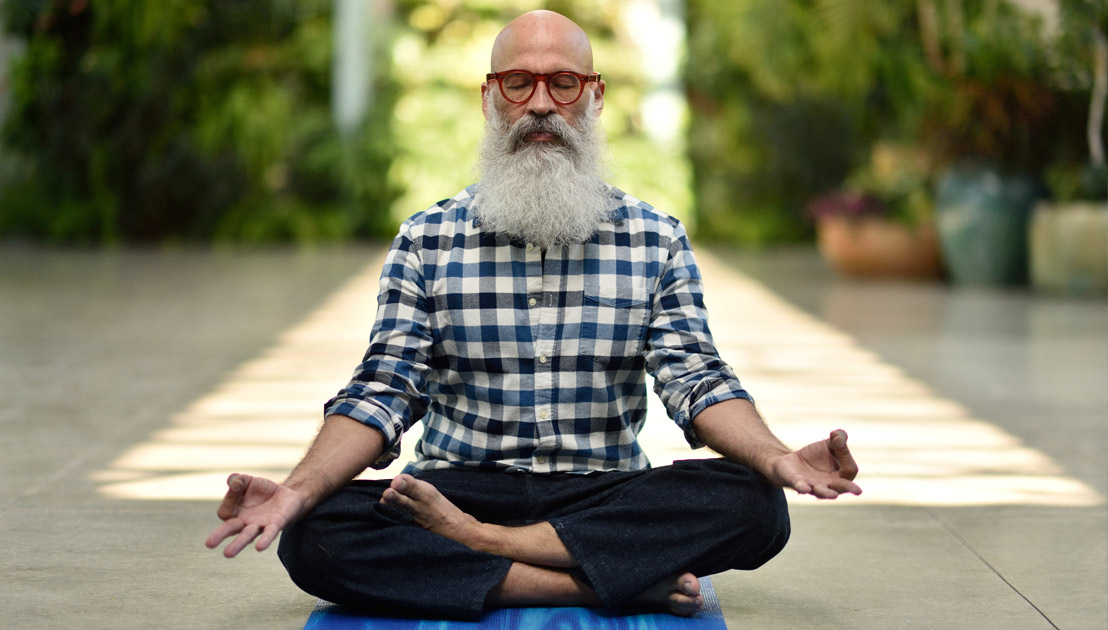
One of the most common questions I hear from new students of mindfulness practice is, “Sitting meditation is really uncomfortable for me. What should I do?”
Like anything else, there are many reasons that people can experience discomfort in sitting meditation. Sometimes the sitting position itself can be a problem. For example, Sukhasana (Easy Pose) is widely thought of as the optimal position for meditation. This might be true for someone whose hips externally rotate easily. But for someone whose hip joints are more prone to internal rotation, Sukhasana is anything but easy.
Other examples: Some people’s knees don’t bend in the ways that traditional sitting meditation requires. Others might not be able to sit with their spines in a neutral position, even when they’re high up on a meditation cushion.
Even if you have the perfect hips and knees to sit on a meditation cushion, you will still likely encounter discomfort. When we sit for any length of time, even on the most comfortable possible seat, discomforts arise. Add to this the fact that mindfulness meditation asks us to pay attention to body sensations. This is the perfect storm for even minor discomforts to blow up into major struggles.
A Matter of Mechanics
It’s important to find the most comfortable seat possible. This involves determining whether your hips are best suited to sitting in a supported Sukhasana or a supported Virasana (Hero’s Pose). Sukhasana requires externally rotated hips, while Virasana works best for internally rotated hips. For the former, V-Shaped Cushions, Zafus and Zen Cushions are great choices. For the latter, sitting on a Zafu or Zen Cushion turned on its side is the way to go. Here’s a post that can help you determine the best cushion or bench for your body.
Some people find that sitting on the floor is not comfortable no matter what support they choose. These people feel better supported sitting in a chair.
How Mindfulness Can Help Sitting Meditation Discomfort
No matter which sitting support you choose, discomfort will probably visit at some point. After all, it’s not just our backs, hips and legs that can experience discomfort. Shoulders, necks, arms, hands, feet—you name it—can all flare up from time to time.
The normal human reaction to discomfort is to try to avoid the unpleasantness. Adjusting our bodies out of the discomfort can give temporary relief. The problem is, when we feel discomfort and try to make it go away, we add struggle to an already challenging situation. The struggle to banish discomfort begets even more discomfort.
In mindfulness practice, we’re encouraged to move toward the discomfort. We’re encouraged to investigate it directly, as part of our mindfulness practice. Depending on the severity of the discomfort, this can be done in smaller or larger doses.
For example, in the case of a minor discomfort such as an annoying itch, we can turn our attention to it and stay a while to watch it unfold. When we look closely at any sensation, we often learn that there’s more to it than we thought. The sensation will wax and wane. It will be intense for a while, and then it may even go away for a few seconds, only to return a little later. When we pay close attention to any physical sensation, we discover that it’s not as solid as we thought.
In the case of a major discomfort, including both chronic and acute pain, we can investigate in small doses. We can make a commitment to look closely for 10 seconds and then move our awareness to a more comfortable part of the body for a minute or so. Then we can return to the discomfort for another 10 seconds.
Of course, you can vary the amount of time you spend with an uncomfortable sensation according to how you feel on a given day. The point in moving toward discomfort is to learn how not to layer struggle on top of the discomfort. So if 10 seconds of deep looking is doable, stay there. If you decide to try 30 seconds or more, feel free to explore this way, but make sure you stop at the point where you start to feel at war with your body.
Moving toward pain may seem like a radical approach. But ultimately, applying mindfulness to discomfort can point us in the direction of freedom. We may not be able to avoid discomfort in our bodies, but we can learn how to be with it without creating even more discomfort. That’s the magic of mindfulness.
